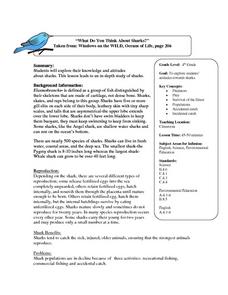Sea World
Shark!
Is that a shark? Here's a 10-lesson unit that will have learners expanding their definition of what a shark actually is as they examine different features, habitats, and diets. They explore endangered species, using information cards...
Curated OER
Animals A to Z: Shark
In this shark worksheet, 3rd graders will add pages to their "animal books." Students will read 10 facts about a shark to gain an understanding of the animal's characteristics.
Curated OER
Shark Quiz
For this science worksheet, students demonstrate their general knowledge about sharks by taking a 15 question quiz. Students write their answers on the lines.
Curated OER
Dolphins or Sharks?
In this dolphins and sharks comparison instructional activity, students complete a web on each animal and choose from a list the attributes that fit each one. Students create a poster promoting conservation of our ocean friends.
Curated OER
Introducing Sharks
In this shark activity, students read and discussion a selection about sharks. Students complete 10 fill in the missing words and complete a crossword puzzle.
Curated OER
What Do You Think About Sharks?
Fourth graders explore sharks. They read a story about sharks and act out using Reader's Theater. They discuss fact and attitude statements about sharks and complete a Shark Survey. They create a shark promotion brochure informing...
Curated OER
Name That Shark!
In this online quiz worksheet, students answer a set of multiple choice trivia questions about names of sharks. Page has a link to answers.
Curated OER
SHARK BODY PARTS
Students list all the parts on the shark and label a diagram of the shark anatomy. They define the words, "gill and fin" and describe what they are used for.
Curated OER
Number Search in Monterey Bay Aquarium
Youngsters search for an animal with body parts for each number from one to ten during a field trip to an aquarium. They count rays, fins, feet, gills, eyes, spots or anything. When they get back to the classroom, they compile their...
Curated OER
Sharks Taxonomy
Students, in groups, establish a classification system for the world of your classroom. They draw a chart to explain their categories and system to the rest of the class.
Curated OER
Animal Analogies
Worksheet is to helpful as grammar is to fun! Work on solving 18 analogies involving animals and their characteristics with an engaging grammar assignment.
Umaine Museum of Art
Bony Fish Anatomy Worksheet
Take time to appreciate the beauty in the anatomy of animals with this cross-curricular art and science activity. After viewing examples of fish-themed artwork, children complete the included worksheet by labeling the different parts of...
Curated OER
Ray Multiple Choice Activity
In this ray worksheet, students complete a ten question multiple choice activity pertaining to sea rays. Prior knowledge is assumed.
Curated OER
Whales and Dolphins Multiple Choice Quiz
In this multiple choice quiz worksheet, 7th graders answer 10 questions based on the book, Whales and Dolphins by Susanna Davidson.
Curated OER
Ray Crossword Puzzle
In this ray worksheet, students complete a ten question crossword puzzle with words that pertain to rays. There is a word bank provided.
Curated OER
Fishy Fish
In this fishy fish comprehension worksheet, students read and assess understanding. In this true and false, fill in the blank, short answer, and multiple choice worksheet, students answer ten question.
Curated OER
Fourth Grade Reading
In this reading worksheet, 4th graders answer multiple choice questions by reading 1/2 page passages and answering comprehension questions. Students complete 25 questions.
Curated OER
Sunken Millions Animals
This PowerPoint includes a game with ocean graphics in which two teams answer increasingly difficult questions about animals. Topics covered include plant and animal cells, animal adaptation, and similarities and differences between...
Curated OER
Fearsome Creatures 1
In this wild animals activity, students fill in the blanks or choose the correct words to sentences about wild animals. Students complete 47 blanks.
Curated OER
Classifying Commercial Marine Species
Students investigate taxonomy. They explore some of the commercial marine species caught in Magdalena Bay and develop a classification system for presented animals.
Curated OER
The Deep
In this deep ocean worksheet, students answer twenty questions after watching a video about the species that live in the deep ocean. Topics include jelly fish, hatchet fish, anglers, tubeworms, sea urchins, and plants that grow in deep...
Curated OER
The Excretory System
In this excretory system worksheet, students read a brief excerpt about water balance and the excretory system. Then they identify what compound birds, insects and reptiles living in dry habitats excrete. Students also describe how...
Curated OER
Sunken Millions
This PowerPoint features a game based on the animal life. The interactive slides include 20 questions about animal needs, animal groups, and animal traits. The questions include multiple choice answers and 4 different levels of...
Curated OER
Verterbrate Classification
Students are introduced to the broad categories of vertebrates including fish, amphibians, reptiles, birds and mammals. They identify the characteristics of each group and then view slideshows and video of example species.

























